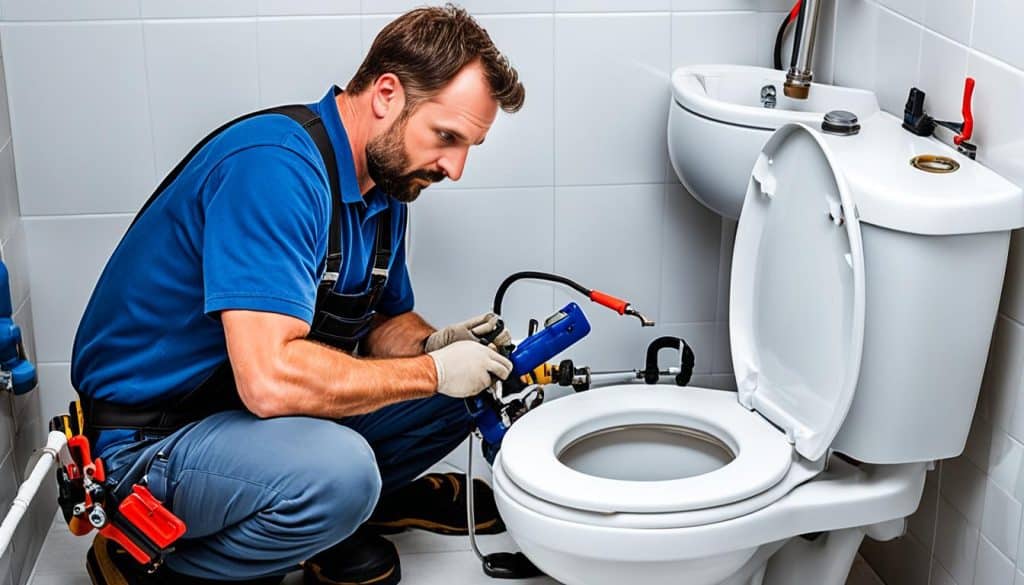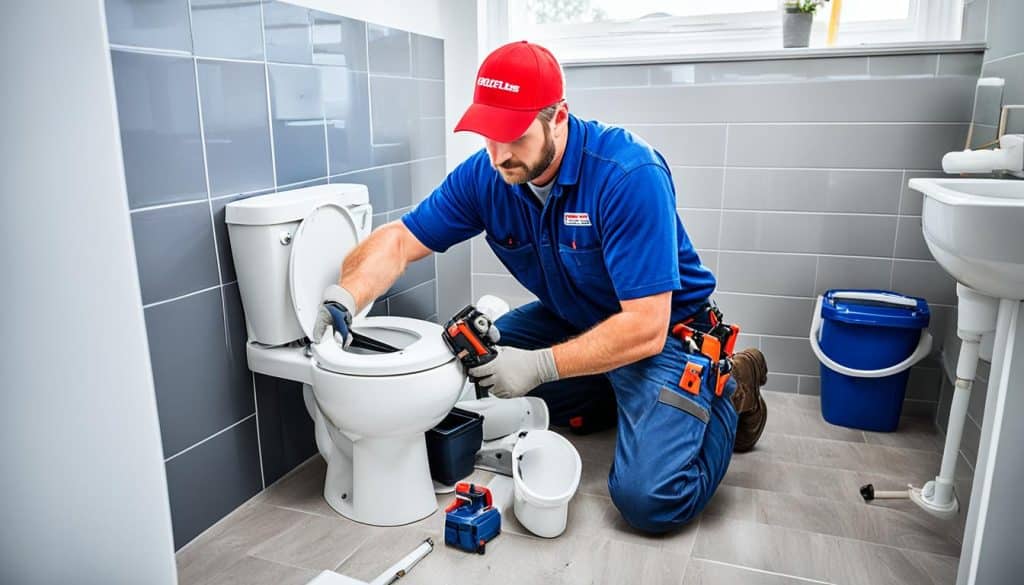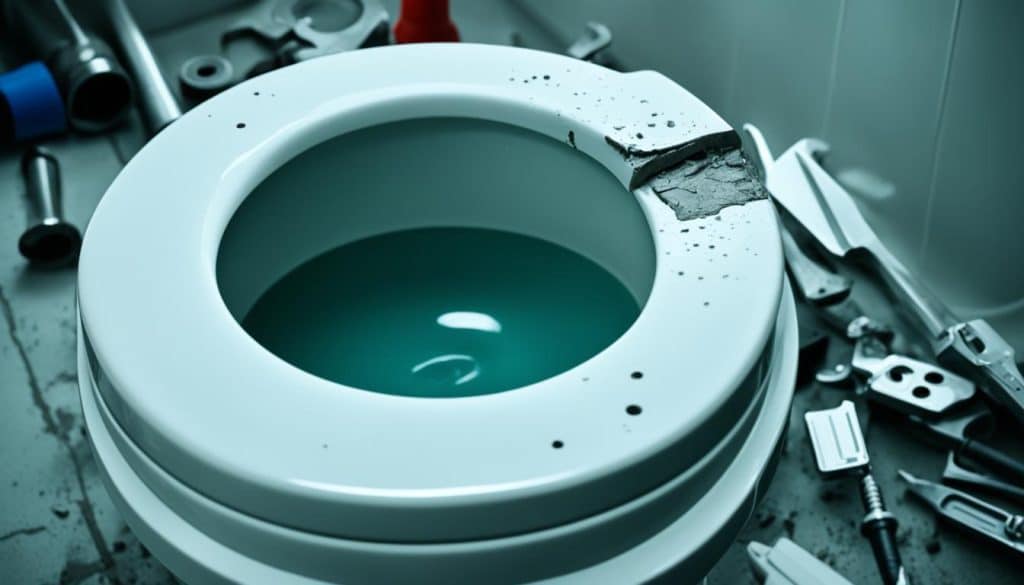What Should I Do if My Toilet Overflows and Will not Stop Running? It’s a nightmare that can cause panic. It risks water damage and makes your bathroom unsanitary. Quick action is key to handle this issue well.
But do you know the right steps to take? How can you fix the overflow and keep your bathroom running smoothly? Read on to learn how to tackle this problem and avoid more damage.
Key Takeaways
- Easily shut off the water supply to prevent extensive damage.
- Knowing the causes of a toilet overflow can prevent recurrence.
- Immediate actions can mitigate water damage and sanitation concerns.
- Simple fixes can often stop a toilet from continuously running.
- Call a professional if in doubt, to avoid making the problem worse.
Immediate Steps to Take When Your Toilet Overflows
Dealing with a toilet overflow can be stressful. But, acting fast is key to prevent water damage. Follow these steps to fix the issue quickly.
Shut Off the Water Supply
The first step is to find and turn off the water supply. It’s usually near the toilet base. If it’s hard to turn, a bit of lubricant can help. This stops more water from overflowing.
Check and Close the Flapper
Then, open the toilet tank lid and check the flapper valve. Closing it stops more water from getting into the bowl. This is a key step in fixing the overflow.
Secure the Float
Lastly, make sure the float ball or cup is up. This stops the tank from filling with water. Quick action with the float is important to control the overflow.

Understanding the Causes of Toilet Overflowing
Figuring out why your toilet is overflowing is key to fixing it. Whether it’s a full-blown emergency or just a constant flow, knowing the cause is essential.
Clogged Drain
A clogged drain is a common reason for toilet overflows. This can happen when you flush things you shouldn’t, use too much toilet paper, or when waste gets stuck. Keeping an eye on these things can help avoid trouble.
Sewer Line Blockage
Blockages in the sewer line can be serious. They might come from things not meant to be flushed, like wipes or sanitary products. They can also be caused by tree roots or dirt. These problems often need a pro to fix to avoid a big mess.
Blocked Vent Pipe
Blocked vent pipes can also cause overflows. These pipes help air flow in the drainage system. If they’re blocked, it can lead to water overflowing.
Broken Toilet Parts
Broken parts in your toilet can also cause overflows. This includes things like a float that’s not working right or a damaged flapper. Keeping these parts in good shape can help prevent overflows and make your bathroom safer.
How to Fix a Toilet That Won’t Stop Running
A toilet that won’t stop running wastes a lot of water and raises your bills. To fix it, you need to follow a few key steps. These steps will help you solve the problem and avoid future issues.
Adjust or Replace the Flapper
The flapper in your toilet tank stops water from flowing to the bowl. If your toilet keeps running, the flapper might be old or not fitting right. You might need to tweak the chain or swap out the flapper to get it to seal properly.
Inspect the Fill Valve
The fill valve is also important. It controls how much water is in the tank. If it’s not working right, water will keep flowing. Look for any blockages or damage and adjust the water level to avoid overflow.
Check the Overflow Tube
Don’t forget to check the overflow tube in your tank. It stops the tank from filling too much. Make sure it’s not broken or out of place. Adjusting these parts can stop your toilet from running nonstop.
Clearing the Clog to Prevent Overflowing
Fixing a toilet overflow often starts with finding and fixing the clog. It might be a small blockage or a big one. Acting quickly is important. Here’s how to fix a toilet clog well.
Using a Plunger
A plunger is your first tool for fixing a clog. Choose one with a flange design for better sealing in toilet drains. Press it down hard to seal, then push down and pull up fast to clear the blockage.
Employing a Toilet Snake
If a plunger doesn’t work, try a toilet snake. It can go deeper to tackle tough clogs. It’s great for removing items that shouldn’t be flushed.

Calling a Professional Plumber
If plunging and snaking don’t help, call a pro plumber. J Sewer & Drain Plumbing Inc. in Chicago, IL, offers top-notch plumbing services. They guarantee their work for 5 years on underground repairs and 1 year on above-ground work. Call them at (773) 968-2704 for help. Their experts can solve any plumbing problem fast.
What Should I Do If My Toilet Overflows and Will Not Stop Running?
If your toilet overflows and won’t stop running, you need to act fast. First, find the shut-off valve at the toilet’s base. Turn it clockwise to stop the water flow. This will help control the overflow.
Then, check the flapper in the toilet tank. A bad fit or damage can cause water to keep flowing. Adjusting or replacing the flapper might fix the problem. If the flapper works right, look at the float mechanism. Make sure it’s set correctly to avoid too much water in the bowl.
If these steps don’t work, the fill valve might be the issue. A faulty fill valve can cause overflows. Cleaning, adjusting, or replacing it can solve the problem. Also, check if the overflow tube is clear and in the right spot.
If a clog is causing the overflow, a plunger or toilet snake might help. But, if the problem persists, you might need a professional plumber. They can handle blocked sewer lines or damaged parts.
Knowing and fixing the cause of a toilet overflow quickly can prevent big repairs and high water bills. These steps can help keep your bathroom working well and clean.
Conclusion
Dealing with a toilet that won’t stop running can be stressful. But, knowing how to handle it makes it easier. First, turn off the water supply to stop more water from coming out. This gives you time to figure out what’s wrong.
Then, check the flapper and float to fix small problems. Knowing why the toilet overflows, like clogs or broken parts, helps fix it for good.
If the toilet runs, you need to make more checks. Look at the flapper, fill valve, and overflow tube. Clearing clogs with a plunger or snake helps too.
If all else fails, call a professional plumber. They can fix it right and protect your home from water damage.
With this info, you’re ready to handle toilet troubles. Fixing problems fast and knowing how they work keeps your plumbing working well. This brings peace of mind and keeps your home running smoothly.
J Sewer & Drain Plumbing Inc. in Chicago, IL, offers top-notch plumbing services. They guarantee their work for 5 years on underground repairs and 1 year on above-ground work. Call them at (773) 968-2704 for help. Their experts can solve any plumbing problem fast.

FAQ
What should I do if my toilet overflows and won’t stop running?
First, turn off the water supply using the main shut-off valve near the toilet. If it’s hard to turn, use some lubricant. Next, close the flapper valve inside the tank to stop water from flowing into the bowl. Lift the float ball or cup to stop the refill process in the tank.
What are the immediate steps to take when my toilet overflows?
First, shut off the water supply. Then, close the flapper valve to stop more water from filling the bowl. Lastly, secure the float to halt the refill in the tank.
How do I shut off the water supply when my toilet is overflowing?
Find the main shut-off valve near the toilet. Turn it clockwise to stop the water flow. If it’s hard to turn, use a lubricant to help.
What causes a toilet to overflow?
Toilet overflows can happen for a few reasons. Clogged drains from items that shouldn’t be flushed or too much toilet paper are common. Also, sewer line blockages from bad disposal or roots can cause problems.
Blocked vent pipes and broken toilet parts, like a wrong filler float or a damaged flapper, can also lead to overflows.
How do I fix a toilet that won’t stop running?
To fix a toilet that won’t stop running, first check the flapper. If it’s faulty, replace it. Then, look at the fill valve for any issues.
Make sure the water level in the tank is below the overflow tube’s top. This helps prevent the running.
What can I use to clear a clogged toilet?
To clear a clogged toilet, use a plunger with a flange design or a toilet snake for tough clogs. If the clog persists, it’s time to call a pro.
When should I call a professional plumber for a toilet issue?
If you’ve tried to fix the clog or running issue but it won’t work, call a pro. J Sewer & Drain Plumbing Inc. can offer expert help.


